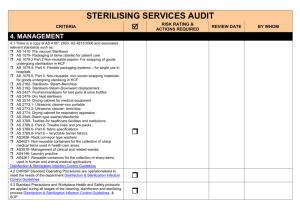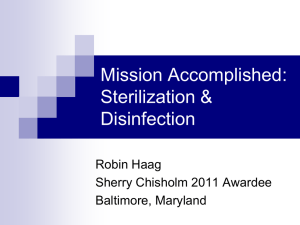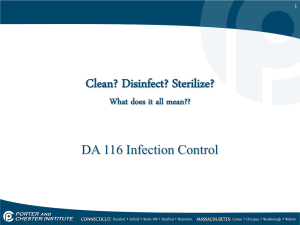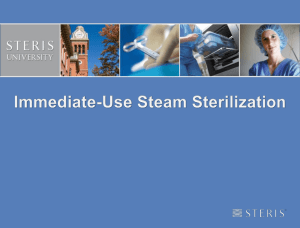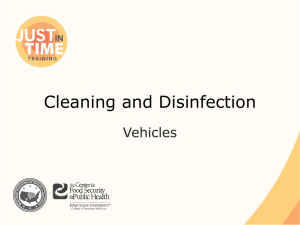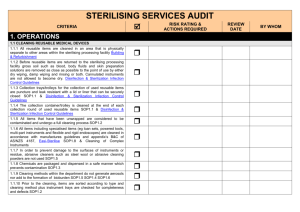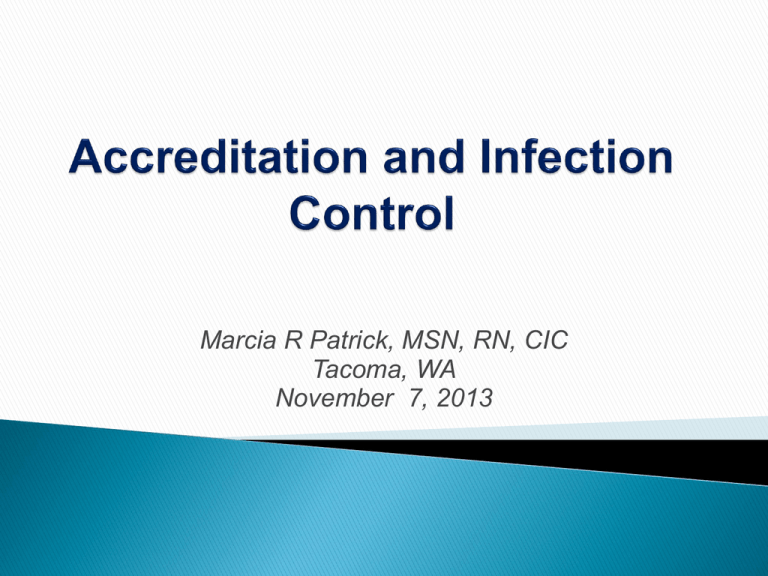
Marcia R Patrick, MSN, RN, CIC
Tacoma, WA
November 7, 2013
I have nothing to declare
No off-label use of medications will be
discussed
Use of brand names and images is for
illustration only, no endorsement is
implied
Be familiar with the salient points of the
CMS Infection Control Worksheet
Discuss three critical injection practices to
prevent transmission of bloodborne
pathogens in the ASC
Describe at least three critical elements in
safely and adequately performing highlevel disinfection in the ASC
Requires all ASCs that accept money from CMS
meet specific Infection Control requirements
Result of disease outbreaks in ambulatory pts.
IC requirements included in all accreditation
surveys
◊ Accreditation Association for Ambulatory Health Care (AAAHC)
◊ American Association for Accreditation of Ambulatory Surgery Facilities
(AAAASF)
◊ American Osteopathic Association (AOA)
◊ The Joint Commission (TJC)
A good idea regardless of accreditation surveys!
It’s all about patient safety
Requires:
Licensed, qualified IC person
Written Infection Control Plan
Which IC standards are being followedCDC (various), AORN, specialty, etc.
Surveillance plan for infections
Method of notifying DOH of reportable dz
Education of staff in infection control
Hand hygiene- wash or alcohol-based hand
sanitizer, appropriate times
Use of gloves, other personal protective equip.
Needle and medication safety: One needle,
one syringe, one patient, one time
Single dose vials are single patient use
Proper placement & use of sharps containers
Sterilization & disinfection
Environmental cleaning
Point of care testing devices (blood glucose)
Protect patients
Protect workers
Ensure compliance with infection
prevention and control regulations and
other requirements, guidelines and
recommendations
Promote “zero tolerance” for infections
1.
2.
3.
4.
5.
Risk Assessment based on services
provided, locale, population
Written Infection Prevention and Control
Plan
Authority Statement
Infection Control Service description
Surveillance Plan
Elements, continued
6.
7.
8.
9.
10.
11.
Goals and Measurable Objectives
Prevention & Control Strategies
Communication and Reporting
Emergency Management & Planning
Education
Evaluation of Program Effectiveness
◊Provides a basis for infection prevention
activities and annual surveillance plan
◊Identify at-risk populations in your facilityhigh volume, high risk, or problem-prone
procedures
◊Assist in focusing surveillance efforts
◊Meet regulatory and other requirements
Epidemiologic principles to address
◊Volumes
◊Populations served
◊General and specialty services
◊Staff
◊Surveillance data
◊Geographic location and size
◊Epidemiologically important organisms
Facility Risk Assessment
Assessment Summary
◊Who is at risk for infection
◊What types of infections
◊Recommendations to reduce risks
Surveillance methodology – how
Surveillance indicators/events - what
◊Risk assessment - why
◊Reasons for selecting indicators
◊Committee/leadership recommendations
◊New services, procedures, treatments
Comparative databases used
Outbreak identification and response
Example: The Board of Directors (Medical
Director/Quality Committee) authorizes and supports
the Director (Manager/etc.) of Infection Prevention to
institute appropriate infection control measures
within the facility. This includes authority to employ
whatever methods necessary when, in their
judgment, there is a reasonable possibility of
immediate danger to any patient(s), personnel or
others in the facility.
Composition
◊Based on organization size, type, services,
needs, regulations & requirements
◊Personnel: number, qualifications, core
competencies, (office) location, hours
◊Medical Director/Epidemiologist/ID consultant
Leadership support
Authority
Reporting structure, other responsibilities
Identify & prioritize goals
◊ Based on risk assessment
◊ Team effort & leadership approval
Goals should address at least:
◊ Limiting acquisition & transmission of pathogens
◊ Limiting unprotected exposure to pathogens
◊ Enhancing hand hygiene
◊ Minimizing risk associated with procedures, devices
& equipment
Develop measurable objective(s)
Provide cost-effective
program
◊Healthcare Associated
Infections = increased cost
◊Infection Control programs =
decreased cost
Limited reimbursement
from CMS for preventable
harm, also other payers
Identify prevention & control strategies
Base on risk for transmission, care
setting, diseases in community
Hand hygiene program
Minimize risk associated with
procedures, devices, equipment
Communication systems
◊Internal
◊External
Reports
◊What is reported
◊How it is reported (written, verbal)
◊Who receives the information
◊How often
Education & training for
◊Health care providers, ancillary staff
New employee orientation, competency evaluations
Annual and as needed infection control education
◊Leaders
◊Infection Prevention and Control personnel
List offerings for the year – Plan a calendar
Must involve collaboration
◊Internal
◊External (local emergency mgmt, health dept.)
Plan for
◊Recognition
◊Response (including influx of infectious pts.)
◊Containment
◊Communication (internal & external)
Evaluate goals & program, ability to meet
Measure success or failure, why
◊ Rate reduction- highlight accomplishments!
◊ Processes improved/Compliance improved
Infection Control Program resources
◊ Personnel
◊ Non-personnel (computers, clerical support)
Collaborate
Establish new goals and objectives
The written Plan documents the
existence of your IC Program
The Plan should incorporate all the
elements required or included in your
program
Reviewed and updated as things change,
at least annually
Identify regulations & requirements
Identify guidelines you will use
Develop outline of Infection
Prevention and Control program
Can use the examples given
Network with others
Consider incorporating your plan
into your annual report
Demonstrate collaboration throughout plan
◊ Leaders, managers, caregivers & others
◊ Collaborate in program development,
implementation, evaluation, and assessment
of resources
Assign responsibility for annual review
Include the essential elements
Distribute your plan widely
Hand Hygiene
CDC Guideline for Hand Hygiene in Healthcare Settings, 2002
http://www.cdc.gov/handhygiene/
Antiseptic – antimicrobial substances (e.g. alcohol,
CHG, triclosan) applied to the skin to reduce
microbial flora
Alcohol-based hand rub – alcohol-containing
preparation applied to the hands to reduce the
number of viable microorganisms
Antimicrobial soap – detergent containing antiseptic
agent
Waterless antiseptic agent – an antiseptic agent that
does not require use of exogenous water
Why we use hand sanitizers
A 24-year-old man who had quadriplegia due to a traumatic spinal cord injury was found on routine surveillance cultures to
have methicillin-resistant Staphylococcus aureus (MRSA) colonization of his anterior nares. He had no history of MRSA infection
or colonization. To assess the potential implications of the patient's MRSA carriage for infection control, an imprint
of a health care worker's ungloved hand was obtained for culture after the worker had performed an abdominal
examination of the patient. The MRSA colonies grown from this handprint on the plate (CHROMagar Staph aureus),
which contained 6 µg of cefoxitin per milliliter to inhibit methicillin-susceptible S. aureus, are pink and show the outline of the
worker's fingers and thumb (Panel A). With the use of a polymerase-chain-reaction assay, the mecA gene, which confers
methicillin resistance, was amplified from nares and imprint isolates. After the worker's hand had been cleaned with alcohol
foam, another hand imprint was obtained, and the resulting culture was negative for MRSA (Panel B). These images
illustrate the critical importance of hand hygiene in caring for patients, including those not known to carry
antibiotic-resistant pathogens. New England Journal of Medicine
1.
2.
3.
4.
5.
6.
7.
8.
9.
Before entering patient room
Before touching patient
Before donning gloves
Before handling meds, linen, clean supplies
Between dirty and clean tasks
After touching patient or their environment
After handling soiled linen, dressings, etc.
On removing gloves
On leaving the room
Surgical Hand Antisepsis
State of the science: waterless surgical scrub
solutions
1. Alcohol-based surgical hand-scrub
Prewash hands and forearms with non-antimicrobial soap,
dry, then apply per manufacturer's instructions
2. Antiseptic surgical hand-scrub
Chlorhexidine (CHG) & Povidone Iodine (PVI) most
common
HCWs more likely to harbor gram negative
pathogens on their fingertips
Outbreak of Pseudomonas aeruginosa in NICU
attributed to artificial fingernails
Artificial fingernails epidemiologically implicated in
several other outbreaks
Do not wear artificial fingernails or extenders when
having direct contact with patients at high risk (e.g.,
those in intensive-care units or operating rooms) (IA)
◊ Skin underneath rings is more heavily colonized than comparable
areas of skin on fingers without rings
◊ Study: 40% of nurses harbored gram-negative bacilli (e.g., E.
cloacae, Klebsiella, and Acinetobacter) on skin under rings &
certain nurses carried the same organism under their rings for
several months
◊ In a more recent study involving >60 intensive care unit nurses,
multivariable analysis revealed that rings were the only
substantial risk factor for carriage of gram-negative bacilli and S.
aureus and that the concentration of organisms recovered
correlated with the number of rings worn
◊ Rings are not appropriate in the OR
◊ Earrings/necklaces must be covered in OR
CDC Guideline for Hand Hygiene in Healthcare Settings, 2002
Perform hand hygiene before accessing and
preparing medications
Disinfect (scrub) all vial tops & IV ports/hubs,
locks with alcohol for 15 seconds before
accessing (includes needleless systems)
◊ Let dry 15 seconds
A needle should never be left inserted into a
medication vial septum for multiple uses
◊ This provides a direct route for microorganisms to enter the vial
and contaminate the fluid
Use 5 micron filter needle for ampule
A new sterile needle and syringe used for each
injection and each entry into vial
Do not use bags or bottles of intravenous solution
as a common source of supply for more than one
patient
Leftover parenteral medications should never be
pooled for later administration
Single-use medication vials (e.g., propofol)
should never be used for more than one patient
Assign multi-dose vials to a single patient
whenever possible
Sanitize hands before any contact
with IV tubing or bag handling or
change
Keep IV bags in plastic overwrap
until ready for use (if out, date &
discard in 30 days)
Begin administration within one hour
of spiking IV bag/bottle (USP 797)
or a soon as possible (APIC)otherwise discard bag
NEVER set an unlabeled syringe down or
leave it unattended
NEVER administer a medication from an
unlabeled syringe that you did not draw up &
have control of from time drawn up to time
given
NEVER draw up an oral or topical liquid into
an injection syringe
Discard medications upon expiration or any time
there are concerns regarding the sterility
Date multidose vials when first entered & discard
at 28 days or manufacturer’s expiration date,
whichever is first
◊ Discard unopened vials at manufacturer’s expiration
date
◊ Discard opened single dose vial/ampule discarded
immediately after use on patient
◊ Discard prepared syringes at end of procedure-do not
save for next case
http://www.cdc.gov/injectionsafety/providers/provider_faqs_multivials.html
Best if irrigation solutions are
discarded between patients
Warming irrigation solutions:
◊T max <113°F, lower (104°) if IV
fluids included (record temp daily)
◊NEVER warm in microwave (any pt
care item!)
Medication containing irrigations:
obtain from Pharmacy - single patient
use
Hand hygiene before & after
Glove if contact with mucous membranes
anticipated
Administer all eye & ear products using
“no touch” technique to prevent
contamination
If break in technique discard the container
ASAP
Prefer single patient use
◊ Sanitize hands
◊ Prevent contamination of bulk
containers; use smallest available
◊ Small size can be dedicated to
single patient and then discarded
◊ Remove desired amount with a
sterile applicator or tongue blade
(no double-dipping) or squeeze
onto a sterile gauze in a clean
area
Improper environment
Inadequate cleaning, disinfection, and
sterilization
◊ Staff not trained adequately
◊ Antiquated equipment
◊ Borrowed equipment
◊ Improper use of equipment
◊ Compromised cleaning procedures
Cleaning: removal of all soil from objects/surfaces
Decontamination: removal of all pathogenic
microorganisms from objects to ensure they are
safe to handle
Disinfection: elimination of many or all pathogenic
organisms with the exception of bacterial spores
Sterilization: complete elimination, destruction of all
microbial life
CDC Guideline for Disinfection and Sterilization in Healthcare Facilities, 2008
Defined as the physical removal of all
visible soil, dust, and other foreign materials
Effective cleaning will reduce microbial
contamination on environmental surfaces &
equipment
Cleaning is the first and most important step
before disinfection or sterilization can occur
CDC Guideline for Disinfection and Sterilization in Healthcare Facilities, 20
Prevents soils & proteins from drying on the
instruments
Softens soils and assists with removal
Prevents biofilm development
Presoaking the instruments should ideally
occur immediately following the surgical
procedure
Sprays, foams, available
AAMI ST79 2010; 7.4.1 p. 53
Detergents are defined as substances
capable of dislodging, removing and
dispersing solid or liquid soils from a
surface being cleaned
Enzymatic detergents usually consist
of a detergent base with a neutral pH
to which one or more enzymes and a
surfactant is added
AAMI ST79, 2010, 7.5.2, p.55
Follows presoaking
Instruments washed submerged under water
to prevent potential exposure to
microorganisms through aerosolization
Use a basket to lift out sharp items
Staff must wear PPE including eye and face
protection
Some endoscope washers may allow you to
eliminate manual cleaning
AAMI ST 79, 2010, 2.17, p.8
Effectiveness is based on cavitation: sonic waves
generate minute bubbles on instrument surface
Bubbles then expand, become unstable, then
collapse or implode
Implosion generates very localized vacuum areas
that literally dislodges/sucks off the soil
Must clean machine per instructions
AAMI ST79, 2010, 7.5.3.3, p. 57
Mechanically cleans instruments using a
spray action called impingement
◊Impingement is the water force making
contact with the instrument
Several cycle processes; final step is
heated air drying
Render instruments safe to handle
In 1972, Dr. Earl Spaulding developed a system for
classifying medical instrumentation and equipment
◊ Non-critical – devices that touch intact skin, environmental
surfaces – LOW LEVEL DISINFECTION
◊ Semi-critical – devices in contact with intact mucous
membranes or skin that is not intact – HIGH LEVEL
DISINFECTION
◊ Critical - (high risk) devices enter sterile tissue or
bloodstream – STERILIZATION
APIC Text, 2009, p. 21-1-5
Device classification
Examples
Spaulding process
classification
EPA Product
Classification
Critical (enters sterile
tissue or vascular
system)
Implants, scalpels,
needles, other
surg. Instruments
Sterilizationsporicidal
chemical;
prolonged contact
Sterilant/
disinfectant
Semi critical (touches
mucous membranes)
Flexible
endoscopes,
laryngoscopes, ET
tubes, vaginal
specula
High level
disinfectionsporicidal
chemical; short
contact
Sterilant/
disinfectant
Hydrotherapy
tanks
Intermediate level
disinfection
Hospital
disinfectant with
label claim for
tuberculocidal
activity
Non critical (touches
intact skin)
Stethoscopes,
Low level
tabletops, bedrails, disinfection
blood pressure
cuffs
Hospital
disinfectant
without label
claim for
tuberculocidal
activity
Kills most bacteria, some viruses, some fungi
Appropriate for non critical medical devices
and environmental surfaces
Quaternary ammonium compounds (Quats)
are low level disinfectants
◊ Many quats are effective against TB and Hepatitis B
OK for use on blood spills and in OR environment
CDC Guideline for Disinfection & Sterilization in Healthcare Facilities, 2008
Have a written procedure for cleaning ALL
environmental surfaces and equipment
◊What, who, when, how
◊EPA-registered hospital disinfectant/detergent
◊Pop-up wipes very handy for small surfaces
◊Spray bottles discouraged, use nozzle top
◊Use original containers or manufacturer's label
APIC Text, 2009, Ch 100
Kills Mycobacterium tuberculosis, vegetative
bacteria (e.g. Staphylococcus aureus), most
viruses & fungi
Most phenolic disinfectants are classified as
intermediate level
Appropriate for hard surfaces, floors, noncritical medical devices
Phenolic disinfectants are used cautiously
where there are infants
APIC Text, 2009, Ch 100
A process (usually liquid chemicals or wet
pasteurization) that eliminates:
◊Many or all pathogenic
microorganisms on inanimate objects
◊Except large numbers of bacterial
spores
◊Short exposure times (<30 minutes)
CDC Guideline for Disinfection & Sterilization in Healthcare Facilities, 2008
Any instrument that will touch mucous
membranes or non-intact skin
◊Flexible endoscopes
◊Ultrasound probes, vaginal and anal, used with
sheath
◊Brushes used to clean instruments for HLD
◊Laryngoscope blades
◊Vaginal specula & related equipment
◊Diaphragm fitting rings
APIC Text 2009, p.21-6.
Endoscopes- GI, GU, can’t tolerate high heat
Sometimes for arthroscopes, laparoscopes
◊ Large studies of HLD arthroscopes have shown no
increased risk of infection compared to sterilized
arthroscopes
Follow label directions for soak time, temperature, use
life, shelf life, product restrictions
◊ No OPA for urology scopes per label on some OPA
products
Use in well-ventilated area, wear PPE
Many HLD products are similar: compare
NEVER use HLD for environmental cleaning!
APIC Text 2009, p.21-3.
Use for temperature-sensitive devices
◊ Glutaraldehyde (> 2.0%) Cidex, Metricide, etc.*
◊ Ortho-phthalaldehyde – OPA (0.55%) many brands
◊ Hydrogen peroxide-HP (7.5%) Sporox
◊ Peracetic acid-PA (0.2%) Steris
◊ HP (1.0%) and PA (0.08%) Peract
◊ HP (7.5%) and PA (0.23%) Endospore (no test strips!)
◊ Glutaraldehyde (1.12%) and Phenol/phenate (1.93%)
Sporicidin
◊ 2% Activated Hydrogen Peroxide (Resert XL)
*Brand names used for illustration only, no endorsement is implied.
APIC Text 2009, p.21-3.
High-Level Disinfection
Glutaraldehyde and Ortho-phthalaldehyde – OPA
◊ Various formulations and brands
Ready to use or requires activation (mixing)
14, 28 and 72 day formulations (maximum use days)
◊ Must use test strips to assess concentration prior to each
use
Minimum Effective Concentration (MEC) specific to each product
◊ Product must be rinsed thoroughly
Sterile or potable water (dependent upon intended use of
instrument)
◊ Maintain log
◊ Must be neutralized for disposal (Glycine)
Immediately: wet wipe down outside of scope
Take to soiled utility room (cart or tray, “enclosed”)
Leak test (if fails, stop and send scope for repair)
Initiate cleaning process- enzymatic soak
Scrub and flush all channels, ports, valves, etc.
Rinse, rough dry
Immerse in HLD for product label-designated time, flush
and fill all channels to prevent air bubbles
Rinse x 3, rinse channels with alcohol, blow dry
Hang vertically to store, closed cabinet preferred
APIC Text 2009, p.21-3.
Perform some or all of the functions: leak testing,
cleaning, disinfection, alcohol rinse and air drying of
scopes
MUST ensure all lumens are properly connected to the
system
APIC Text 2009, p.21-6.
Dilution of chemical occurs during routine use
Test strips for monitoring the MEC, specific to
each product; test prior to each use, log
Do not use test strips beyond expiration date
QC test & document when opening a new bottle;
refer to manufacturer’s protocol
AORN Perioperative Standards & Recommended Practices, 2012, p. 489
Tray/
Equipment
Date
Processed
Solution
Expiration
Date
Test Strip
Expiration
Date
MEC Test
Result
(+ Pass or
- Fail)
Solution
Temperature
Solution
Soak Time
IMPORTANT!
Solution must be discarded by
expiration date, EVEN when
MEC test passes
Test Strip Example
- Fail
+ Pass
Initials
Key Infection Prevention Interventions for
cleaning and processing endoscopes
◊ Keep the scope moist – enzymatic soak
◊ Transport in covered container
◊ Consistent and complete cleaning of all channels
◊ Manual cleaning includes
Valves
Channels
Connectors
All detachable parts
Brushes
Multisociety Guideline on Reprocessing Flexible Gastrointestinal Endoscopes, 2011
SGNA published updated guidance 9.12
Cleaning/Disinfection in
Endoscopy Setting (2)
◊Leak testing and scope inspection
◊Processing: Per manufacturer
Chemical
Automated endoscope washer-
disinfector
Use alcohol for final rinse, blow air
◊Hang to dry (vented cabinet
designed for hanging and storage of
scopes)
◊Do not store in case!
Documentation log
◊Patient name
◊Type of scope - Serial number
◊Date and time of processing
◊Enzymatic soak time if manual
◊Chemical indicator results
◊Machine – bay number
◊Soak time if manual
◊Soak temperature
◊Attach print-out if available
ENDOSCOPY REPROCESSING LOG
Today’s Date: ___________________
Results Of Pre-Process Test:___________
Disinfectant: ____________________
Expiration Date Of Test Strips:__________
Activation Date: _________________
Patient
Name
Processor
#
Load #
Scope
Leak
Test
Cleaning
Time
Soak
Time
Soak
temp
Rinse
Alcohol
Purge
Initials
Training of ALL staff responsible for cleaning
instruments, scopes, equipment (vacations?)
Post the procedure in work area
Ensure proper equipment, PPE, supplies
available
Competency evaluation initially & at least
annually
Maintain training records
Periodic visual monitoring of practice
Consider microbiological monitoring if indicated
AAMI ST79 2010, 4.2, p. 37
http://www.unc.edu/depts/spice/dis/Endoscope.html
Thermal (Heat)
◊ Moist (Tabletop or large; Gravity, & High Speed
Vacuum)
Example of a tabletop
◊ Dry
steam autoclave.
Chemical
◊ ETO (ethylene oxide, “gas”)
◊ Other chemicals- H2O2 gas plasma (Sterrad);
Steris
◊ Ozone- commercial use
◊ Radiation- commercial use
CDC Guideline for Disinfection & Sterilization in Healthcare Settings, 2008, p. 59
Low cost, quick turnover, no toxic chemicals,
accommodates large loads
Steam enters the chamber by gravity &
displaces air (so steam can penetrate load)
Takes longer for steam to reach required
temperature
May not penetrate complex instruments
CDC Guideline for Disinfection & Sterilization in Healthcare Settings, 2008, p. 59-60
Low cost, quick turnover, no toxic chemicals,
accommodates large loads
Air is removed (so steam can penetrate load)
by a pump before steam at an elevated
temperature is rapidly introduced, then rapidly
removed at end to facilitate drying
Will penetrate complex instruments
CDC Guideline for Disinfection & Sterilization in Healthcare Settings, 2008, p. 59
Dry Heat Sterilization
Mechanical convection – more efficient and
temperature is more uniform
340°F for 60 minutes, dental 320°F for 2 hours
Used for powders and oils that can tolerate
high temperatures
See AAMI ST40
AAMI ST79, 2010, 8.5.8, p. 81
CDC Guideline for Disinfection & Sterilization in Healthcare Settings, 2008, p. 68
Low Temperature Sterilization
Ethylene oxide (EtO/EO);
Used for heat & moisture sensitive devices
Lengthy aeration time must follow each cycle to
allow removal of harmful residuals before
opening chamber doors
EtO/EO is associated with human tumors
Alarms, ventilation and training of staff promote
safe use of this agent
CDC Guideline for Disinfection & Sterilization in Healthcare Settings , 2008, p. 61
Hydrogen Peroxide Gas Plasma
Sterilizer
CDC Guideline for Disinfection & Sterilization in Healthcare Settings , 2008, p. 61
Use the correct wrapper for the type of
sterilization to be performed, items to be
packaged
Wrappers must have a 510k that specifies
what it can be used for (ETO, steam, etc.)
Same for peel packs
AORN Standards & Recommended Practices, 2012, p. 537-545
Peracetic Acid Sterilizer
Steris 1
gone by
Feb. 2, 2012
Steris 1e
FDA Approved
Flash Sterilization- Now Called
“Immediate Use Steam Sterilization”
Definition:
◊ AAMI: “process designed for the steam sterilization of
patient care items for immediate use”
◊ AORN: “should be used only when there is insufficient time
to sterilize the item by the preferred wrapped or container
method”
Not recommended outside of the ambulatory surgical center
where it can be used in a controlled manner
Should never be used as a substitute for sufficient inventory
AAMI ST79, 2010, 8.8, p. 86
Acceptable only for items:
AAMI guidelines for implants
AORN guidelines for implants
Single instruments only (not trays)
Urgently needed
Cleaned well
Used close to point of sterilization
Adequately covered or protected from
contamination
Use mechanical, chemical, and biological
indicators
AORN Standards and Recommended Practices, 2012, p.550-552
Immediate Use Sterilization
Considerations:
Risk of burns from hot instruments
Recontamination of instruments during
transport
Keep logs of all immediate using (process
surveillance)
Monitor number of times used, what
procedures, and why – use as dept PI
Monitor staff training and performance
AORN Standards and Recommended Practices, 2012, p.550-553
Critical Parameters for each load
◊Steam
◊Temperature
◊Pressure
◊Time
AAMI ST79, 2010, p. 97-102
Class I – External, time, temp, pressure indicator, says item
went through autoclave (tape)
Class II – Bowie Dick, checks for air removal
Class III – Internal, time & temp, rarely used today
Class IV – Internal, reacts to two or more parameters,
rarely used today
Class V – Integrators, melted chemical pellet, reacts to all
parameters, all steam cycles
Class VI – Emulating indicators, cycle specific
Biological – gold standard, shows kill of organisms
AORN Standards and Recommended Practices, 2012, p. 564-565
Cycle time, temperature, &
pressure is displayed on the
sterilizer gauges with each
instrument load
Printout or graph documents
these indicators
If these fail, load is no good.
The CI is a process indicator that signals the
item has been exposed to sterilization process
(temperature, time, etc.)
A CI is affixed to outside of package & used
with every load
An indicator is also placed inside the pack to
verify steam penetration
Peel-packs have a single indicator
If these fail, load is no good
Closest to being the ideal monitor & measure of
effectiveness by challenging the sterilization
process against a resistant spore (Bacillus sp.)
Use BI daily if sterilizer is used frequently
Also, use a BI for every implant & EtO run
Policy for positive tests- who to notify, id
instruments used, recall? “IC Communication”
report
Compare capsules for color
change at regular intervals
Length varies with the product;
rapid readout 1-3 hours, or 24
hours
Read and record results
Positive test = sterilization
process has failed due to
improperly processed load,
failure to meet temperature or
exposure parameters,
mechanical problems, etc.
Yellow = Positive
Purple = Negative
Documentation: Note the Control is positive the Biological is negative
Positive BIs
Remove sterilizer from service until problem resolved
Consider recalling packs processed since last “good”
load
Check sterilizer records or logs to see if all other
critical parameters were met
Repeat the BI in 3 separate loads
◊ If all are negative and critical parameters are met, place it back
into use
◊ If one or more continue to be positive
Have machine serviced
Repeat BI using a different manufacturer or lot of indicators
AAMI ST79, 2010, 10.7.5, p. 114
Store at least
◊ 8-10” from the floor
◊ 18” from the ceiling
◊ 2” from outside walls
Solid bottom shelf
Closed cabinets
Avoid overfilled drawers
NO RUBBER BANDS!
AORN Standards & Recommended Practices, 2012, p. 559
Historically, sterile items had an expiration
date… yet items don’t suddenly convert from
sterile to non-sterile
Event-related sterility states the product does
not have an expiration date providing the
package is intact (e.g. wrapping intact,
package is not wet, etc.)
Sterility is event related, not time
related!
AORN Standards & Recommended Practices, 2012, p. 560
Manufacturers cite “single use only” on many of their
products (e.g. cardiac caths, orthopedic bits/blades,
DVT sleeves, etc.)
Re-use of these products can result in significant
financial savings
Concern with the risk of infection and injury when the
devices are re-used
Must consider regulatory, medical, ethical, legal, &
economic issues before proceeding forward
3rd party reprocessing acceptable when premarket
requirements are met (FDA 510(k)) (amdr.org)
http://www.fda.gov/MedicalDevices/DeviceRegulationandGuidance/ReprocessingofSingle-UseDevices/default.htm
Vendor
◊ Must wear appropriate attire in OR
◊ Name badge; should meet employee criteria for
medical screening and immunization
◊ Bring written cleaning, disinfection, sterilization
instructions from manufacturer of device
Equipment
◊ Must be delivered to the CS decon for cleaning and
sterilization (with instructions)
◊ Allow adequate time for processing
◊ Record “borrowed” equipment contents, vendor
name, patient or case number involved, surgeon
name, date and time, keep a log
AORN Standards & Recommended Practices, 2012, p. 558
CMS and accreditation requirements
are all about patient safety
Risk assessment, written plan,
evaluation of program, document
Hand hygiene, hand hygiene…
Safe injection practices
Cleaning, disinfection, sterilization
Environmental cleaning
marcia.patrickip@gmail.com

